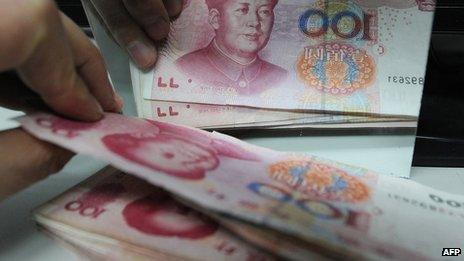China loosens grip on interest rates
- Published

China has been looking to loosen its grip on the financial and capital markets
China has taken another step in liberalising its financial sector by loosening its grip on interest rates.
The central bank has said it will allow banks to trade deposits with each other from Monday, using a financial product called certificates of deposit.
The interest rate on the certificates will be determined by the market, unlike ordinary deposits, which are subject to rate caps in China.
The move is also likely to help improve cash circulation in interbank market.
In June, the overnight lending rate between banks jumped to exceed 25% at one point as banks became reluctant to lend to each other amid a cash crunch, before falling in subsequent days.
China's state-owned Xinhua news agency said the latest move, external "will allow banks to borrow at more stable costs in the interbank market".
The minimum amount for an individual certificate of deposit will have to be 50m yuan ($8.2m; £5m) and banks will also have to inform the central bank in advance about how much they plan to issue in a year.
Easing controls
After years of robust expansion, China has seen its growth rate slow in recent times.
It has also faced calls to rebalance its growth model - moving away from investment and export-led growth to one driven by consumption.
Liberalising its financial and capital markets is seen by many as key to Beijing achieving that and spurring a fresh wave of economic growth.
For their part, Chinese policymakers have indicated that they are looking to loosen their grip on the tightly controlled sector.
In September, China launched a free-trade zone in Shanghai where controls on key sectors will be eased.
Measures to be trialled inside the zone include market-driven interest rates and allowing China's heavily-regulated currency, the yuan, to be swapped freely for other currencies.
In July, the central bank, People's Bank of China (PBOC), scrapped the lower limit on lending rates offered by financial institutions, a key step towards liberalising interest rates.
The move was also aimed at cutting financing costs for businesses and consumers to help stoke domestic consumption.
- Published27 September 2013
- Published24 June 2013
- Published8 June 2012